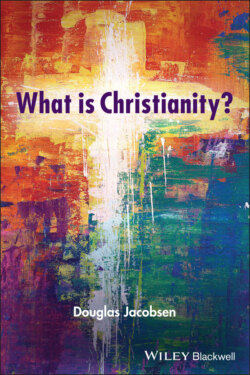What is Christianity?

Реклама. ООО «ЛитРес», ИНН: 7719571260.
Оглавление
Douglas Jacobsen. What is Christianity?
What Is Christianity?
Contents
List of Illustrations
List of Tables
Guide
Pages
List of Figures
List of Tables
Introduction What Is Christianity?
Notes
1 Christian Beginnings
The Jewish Roots of Christianity
Jesus and the Gospel
Christianity’s Original Diversity
Emergence of the Great Church
The Roman Imperial Church
Christian Diversity and Unity in the Year 500
The Great Division
The “Traditioning” of Christianity
Notes
2 Orthodoxy Preserving Ancient Ways
Orthodox Spirituality
The Orthodox Understanding of Salvation
Orthodox History
The Expansion and Consolidation of Orthodoxy in Byzantium, 500 to 900
Orthodoxy in a Slowly Faltering Empire, 900 to mid-1400s
Orthodoxy After the Fall of Byzantium, 1453 to the Present
Institutional and Social Structure of Orthodoxy
Notes
3 Catholicism The Church
Catholic Spirituality
The Catholic Understanding of Salvation
Catholic History
The Conversion of Europe, 500 to 1000
Consolidating the Catholic Tradition, 1000 to 1500
Catholicism Challenged and Reaffirmed: 1500 to 1900
Uncharted Territory: 1900 to the Present
Institutional and Social Structure of Catholicism
Notes
4 Protestantism The Bible and the Individual
Protestant Spirituality
The Protestant Understanding of Salvation
Protestant History
Protestantism’s Diverse Origins, 1500 to 1650
Three New Protestant Spiritual Orientations, 1650–1800
World Missions and Modern Knowledge, 1800–1950
Global Protestant Dynamics, 1950 to the Present
Institutional and Social Structure of Protestantism
Notes
5 Pentecostalism The Power of the Spirit
Pentecostal Spirituality
The Pentecostal Understanding of Salvation
Pentecostal History
Institutional and Social Structure of Pentecostalism
Notes
6 Becoming Global
Catholic Globalization
Protestant Globalization
The Bigger Picture: From Eurocentrism to World Christianity
Notes
7 The Contemporary Geography of Christianity
Mapping Christianity’s Regional Differences
The Middle East and North Africa (1 percent of all Christians worldwide)
Eastern Europe (12 percent of all Christians worldwide)
Western Europe (13 percent of all Christians worldwide)
India and Central Asia (3 percent of all Christians worldwide)
Sub-Saharan Africa (24 percent of all Christians worldwide)
East Asia (10 percent of all Christians worldwide)
Latin America (25 percent of all Christians worldwide)
North America (11 percent of all Christians worldwide)
Oceania (1 percent of all Christians worldwide)
Christian Interactions Today
Note
8 Common Threads and Shared Challenges
Common Threads in the Early Christian Movement
The Modern Search for Christian Unity
Christian Commonalities Today
Common Worship Practices
Common Christian Doctrines
Common Spiritual Grammar
Contemporary Challenges
Christianity and Local Religions
Christianity and Islam
Christianity and the Religiously Unaffiliated
Christianity and the Anthropocene Era
Notes
Conclusion What Is Christianity Today?
Notes
Index
WILEY END USER LICENSE AGREEMENT
Отрывок из книги
Douglas Jacobsen
1.2 Geographic locations of the three traditions created by the Great Division
.....
With the approval and generous financial support of Roman authorities, Christians began building large and spectacular church buildings. Before the year 300, Christians had generally worshiped in relatively small quarters, often meeting in a house or similarly sized building. Once Christianity became the official religion of the empire, modest and provisional structures no longer seemed adequate or appropriate. New buildings were needed that could compete with or even outshine the grandeur of the older temples of Roman paganism, and enormous amounts of money were devoted to building massive, architecturally impressive church buildings called basilicas. As the architecture of the Christian movement changed, the visual art inside those buildings also changed. Most noticeably, Jesus got older and sterner. In the early centuries of Christianity, Jesus was typically pictured as a young, beardless shepherd carrying a lamb over his shoulders. The new portrayals typically depicted Jesus as a bearded, middle-aged judge or ruler on a throne (see Figure 1.1). Simultaneously, Christian worship became more elaborately choreographed, tailored to fit the magnificence of the new church buildings. Worship began to feel much more like an imperial court ritual than like a gathering of friends. Together, these changes signaled a major shift in Christian identity. Christianity was no longer the faith of social outcasts; it had become the faith of the prominent and powerful.
Figure 1.1 Figure of Jesus as a young shepherd (from the catacomb of Priscilla, Rome, third century) and Jesus as a middle-aged judge (from the Chora Church in Istanbul, originally constructed in the later fourth century). Source: Image on left: Joseph Wilpert, https://commons.wikimedia.org/wiki/File:Good_Shepherd_Catacomb_of_Priscilla.
.....